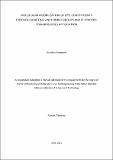| dc.description.abstract | Triphenylamine based dyes molecular modification by grafting anchoring groups and spacers
was
performed
within
computational
framework
aimed
at
potential
materials
for
dye-
sensitized solar cells (DSSCs) application. For the modification, benzothiadiazole-like
spacers, heterocyclic anchoring groups and heteroatom doping have been taken into account.
The reported structural and optoelectronic properties of the dyes were realized through
density functional theory and time-dependent density functional theory using B3LYP and
CAM-B3LYP functionals coupled with 6-31G(d,p) and 6-31G+(d,p) basis sets. The findings
show that presence of atoms of nitrogen and sulphur in the -spacers has a beneficial impact
on the material‟s properties, whereas the branched -spacer impairs the electronic light
absorption characteristics of the sensitizers. The heterocyclic anchoring units result in a
bathochromic shift with maximum absorption within 450 − 600 nm. The computed light harvesting
efficiencies, excited-state lifetimes, electron injection and regeneration abilities
prove that dyes with heterocyclic anchoring groups to be potential candidates for DSSC
applications. The heteroatom doping demonstrates that the chalcogens enhance the absorption
and fluorescent emission spectra of the isolated dyes in the visible and near infra-red regions
with maximum wavelength 504 – 556 nm and 637 – 732 nm, respectively. Simulation of the
dyes attachment to the TiO
2
surface was undertaken; two models of the crystal surface
considered, TiO
2
slab and hydrogenated (TiO
2
)
6
cluster. Among possible adsorption modes of
the dye@TiO
2
complexes, monodentate, bidentate and tridentate, the bidentate mode was
found thermodynamically more favourable. In both, individual dyes and dye@TiO
2
complexes, less electronegative dopants contributed to the improvement of the UV-Vis
spectra and redistribution of electron density. The calculated energies of the dye@TiO
2
attachment relate to dopant heteroatoms; stronger binding is observed in the complexes with
heavier heteroatoms – selenium and tellurium. The adsorption energy magnitudes range
between 0.11 − 1.75 eV for the TiO
2
slab and 7.61 − 9.48 eV for (TiO
2
)
6
cluster. Energy
difference between the two binding models was found to correspond to the enthalpy of
sublimation of TiO
2
from the TiO
2
anatase. One can anticipate that systematic modification
of dyes‟ building blocks may lead to novel materials with suitable characteristics for
application in DSSCs. | en_US |

